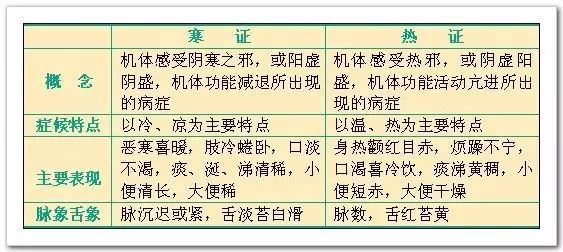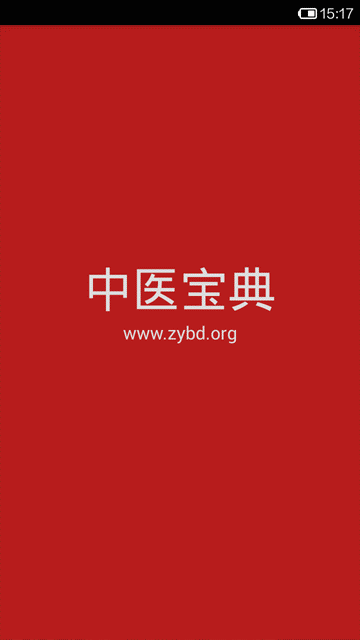

Cold and heat are two fundamental principles for differentiating the nature of diseases. Cold syndromes and heat syndromes reflect the relative excess and deficiency of Yin and Yang in the body. An excess of Yin or deficiency of Yang manifests as a cold syndrome; an excess of Yang or deficiency of Yin manifests as a heat syndrome. The differentiation of cold and heat syndromes is of great significance in treatment. As stated in the “Suo Wen: The Great Discussion of True Essentials”: “Cold is treated with heat,” and “Heat is treated with cold,” indicating that the treatment methods for the two are exactly opposite. Therefore, the differentiation of cold and heat syndromes must be precise and accurate.
1. Cold Syndrome
A cold syndrome is a pathological condition characterized by cold nature. It can be caused by the invasion of cold pathogens or by the body’s own Yang deficiency and Yin excess.
Due to different causes and locations of cold syndromes, several different patterns can be identified. For instance, the invasion of cold pathogens can affect the exterior or penetrate to the interior organs, leading to distinctions between exterior cold and interior cold. The causes of interior cold can be due to the invasion of cold pathogens or inherent Yang deficiency, thus distinguishing between excess cold and deficient cold. Here, we will first analyze the common characteristics of cold syndromes.
[Clinical Manifestations] The clinical manifestations of various cold syndromes are not entirely consistent, but common symptoms include: aversion to cold with a preference for warmth, pale complexion, cold limbs curled up, lack of thirst with a pale tongue, clear and thin phlegm, clear and long urine, loose stools, a pale tongue with a white and slippery coating, and a slow or tight pulse.
[Syndrome Analysis] Insufficient Yang Qi or injury from external cold fails to exert its warming effect on the body, resulting in cold limbs and a pale complexion. The internal excess of Yin cold does not harm the fluids, hence the lack of thirst. Yang deficiency fails to transform fluids, leading to clear and cold excretions such as phlegm, saliva, urine, etc. Cold pathogens injure the spleen, or prolonged deficiency of spleen Yang leads to impaired transformation and transportation, resulting in loose stools. Yang deficiency fails to transform, and internal cold dampness arises, thus the tongue appears pale with a white and slippery coating. Weak Yang Qi results in insufficient force to promote blood circulation, hence a slow pulse; cold constricts, and exposure to cold leads to a tight pulse.
2. Heat Syndrome
A heat syndrome is a pathological condition characterized by heat nature. It can be caused by the invasion of heat pathogens or by the body’s own Yin deficiency and Yang excess.
Based on the different causes and locations of heat syndromes, several different patterns can also be identified. For example, external heat pathogens or heat invading the interior can lead to distinctions between exterior heat and interior heat. Among interior heat, there can be excess heat from invasion or deficiency heat caused by weakness, thus distinguishing between excess heat and deficient heat. Here, we will analyze the common characteristics of heat syndromes.
[Clinical Manifestations] The manifestations of various heat syndromes are also not entirely consistent, but common symptoms include: aversion to heat with a preference for coolness, thirst with a preference for cold drinks, flushed face and red eyes, restlessness, yellow and thick phlegm, hemoptysis, short and red urine, dry and hard stools, a red tongue with a yellow and dry coating, and a rapid pulse.
[Syndrome Analysis] An excess of Yang heat leads to aversion to heat and a preference for coolness. Fire heat injures Yin, depleting fluids, hence the thirst for cold drinks. Fire rises, causing a flushed face and red eyes. Heat disturbs the mind, leading to restlessness. Fluids are boiled by Yang heat, resulting in yellow and thick secretions. Fire heat injures blood vessels, causing hemoptysis. Intestinal heat and fluid depletion lead to constipation. A red tongue with a yellow coating indicates heat syndrome, while a dry tongue with little fluid indicates Yin injury, and the rapid pulse reflects accelerated blood flow due to excess Yang heat.
 3. Differentiation between Cold and Heat Syndromes
3. Differentiation between Cold and Heat Syndromes
To differentiate between cold and heat syndromes, one cannot rely solely on a single symptom; rather, a comprehensive observation and analysis of the entire clinical presentation is necessary, especially regarding preferences and aversions to cold and heat, thirst or lack thereof, complexion (red or pale), temperature of the limbs, as well as the characteristics of urination, tongue, and pulse.
4. Relationship between Cold and Heat Syndromes
Although cold and heat syndromes are fundamentally different, they are interrelated. They can appear simultaneously in the same patient, presenting as mixed cold and heat symptoms, and can also transform into one another under certain conditions, leading to cold transforming into heat and heat transforming into cold. During the progression of a disease, especially in critical stages, phenomena of false cold or false heat may also occur.
(1) Mixed Cold and Heat
When cold and heat syndromes appear simultaneously in the same patient, it is referred to as mixed cold and heat. There are different types of mixed cold and heat, including upper and lower mixed cold and heat, and exterior and interior mixed cold and heat.
1. Upper and Lower Mixed Cold and Heat: The upper and lower parts of the patient’s body exhibit different cold and heat characteristics, referred to as upper and lower mixed cold and heat. This includes both upper cold and lower heat, and upper heat and lower cold. The terms upper and lower are relative concepts. For instance, the diaphragm is considered the boundary, with the chest being the upper part and the abdomen being the lower part. The upper abdomen (stomach area) is considered upper, while the lower abdomen (bladder, large and small intestines) is considered lower.
(1) Upper Cold and Lower Heat: The patient exhibits cold symptoms in the upper body and heat symptoms in the lower body at the same time. For example, cold pain in the stomach area with vomiting of clear saliva, while also experiencing frequent urination, painful urination, and short red urine, indicating cold in the stomach and heat in the bladder. This represents cold in the middle burner and heat in the lower burner, with the middle burner being above the lower burner in relative position, thus classified as upper cold and lower heat.
(2) Upper Heat and Lower Cold: The patient exhibits heat symptoms in the upper body and cold symptoms in the lower body at the same time. For example, the patient may feel heat in the chest and cold in the intestines, presenting with symptoms of heat in the chest such as restlessness, sore throat, and dry mouth, while also experiencing abdominal pain with a preference for warmth and loose stools, indicating upper heat and lower cold.
2. Exterior and Interior Mixed Cold and Heat: The patient has the same disease but exhibits different cold and heat characteristics in the exterior and interior, referred to as exterior and interior mixed cold and heat. This includes exterior cold and interior heat, and exterior heat and interior cold.
(1) Exterior Cold and Interior Heat: The patient has the same disease but exhibits cold in the exterior and heat in the interior. This is commonly seen in cases where there is pre-existing internal heat, and the patient is also exposed to wind-cold, or where an external pathogen transforms into heat while the exterior cold has not resolved. For example, aversion to cold with fever, no sweating, headache, body aches, shortness of breath, restlessness, and thirst, with a floating and tight pulse indicating cold in the exterior and heat in the interior.
(2) Interior Cold and Exterior Heat: The patient has the same disease but exhibits heat in the exterior and cold in the interior. This is commonly seen in cases where there is pre-existing interior cold and the patient is also exposed to wind-heat; or where the exterior heat syndrome has not resolved, leading to damage to the Yang Qi of the spleen and stomach. For example, a patient with a history of spleen and stomach Yang deficiency who is exposed to wind-heat may present with fever, headache, cough, and sore throat (exterior heat syndrome), while also experiencing loose stools, clear and long urine, and cold limbs (interior cold syndrome).
The differentiation of mixed cold and heat syndromes requires not only distinguishing between upper and lower, exterior and interior locations but also clarifying the relative amounts of cold and heat. If cold predominates over heat, treatment should focus on addressing the cold while also considering the heat; if heat predominates over cold, treatment should focus on addressing the heat while also considering the cold.
(2) Transformation of Cold and Heat
1. Transformation of Cold Syndrome into Heat Syndrome: The patient initially presents with a cold syndrome, which later transforms into a heat syndrome, with the cold symptoms gradually disappearing. This transformation is often due to an excess of Yang Qi, where cold pathogens transform into heat, or may occur due to improper treatment or excessive use of warming and drying herbs. For example, a patient with an initial presentation of exterior cold syndrome, experiencing aversion to cold and fever, body aches without sweating, a white coating on the tongue, and a floating and tight pulse. As the condition progresses, the cold pathogens invade the interior and transform into heat, leading to the disappearance of cold symptoms and the emergence of high fever, restlessness, thirst, a yellow coating on the tongue, and a rapid pulse, indicating a transformation from exterior cold to interior heat.
2. Transformation of Heat Syndrome into Cold Syndrome: The patient initially presents with a heat syndrome, which later transforms into a cold syndrome, with the heat symptoms gradually disappearing. This transformation is often due to an excess of pathogens or deficiency of the body’s righteous Qi, leading to functional decline; it may also occur due to improper treatment or loss of Yang Qi. This transformation can be gradual or rapid. For example, chronic heat dysentery may lead to a gradual transformation into deficient cold dysentery due to depletion of Yang Qi. In contrast, a patient with high fever may experience sudden drops in body temperature due to excessive sweating, vomiting, or diarrhea, leading to a rapid transformation into a cold syndrome (loss of Yang).
The transformation of cold and heat syndromes reflects the dynamics of excess and deficiency. The transformation from cold to heat indicates that the righteous Qi is still strong, and the cold pathogens are constrained and transformed into heat; the transformation from heat to cold often indicates an excess of pathogens and deficiency of the righteous Qi, where the righteous Qi cannot overcome the pathogens.
(3) True and False Cold and Heat
When cold or heat syndromes reach an extreme point, there may sometimes be false manifestations that are contrary to the essence of the disease, such as “true cold appearing as heat” or “true heat appearing as cold,” known as true cold and false heat, or true heat and false cold. These false manifestations are often seen in critical stages of the disease, and if not carefully observed, can lead to life-threatening consequences.
1. True Cold and False Heat: This is a condition where true cold exists internally, but false heat is observed externally. The mechanism arises from the internal excess of Yin cold obstructing Yang externally, leading to a phenomenon where Yin is excessive internally and obstructs Yang externally, resulting in false Yang appearing as if it were Yang. Symptoms may include: body heat, a flushed face, thirst, and a large pulse that seems to indicate a heat syndrome, but the patient, despite feeling hot, desires to be covered, has a thirst for hot drinks but can only drink a little, and the flushed face appears intermittently, not resembling the full redness of true heat, with a large pulse that feels weak upon palpation. Additionally, symptoms such as cold limbs, clear diarrhea, and clear and long urine, a pale tongue with a white coating may also be present. Therefore, the heat manifestation is false, and the essence of the disease is Yang deficiency with excessive cold.
2. True Heat and False Cold: This is a condition where true heat exists internally, but false cold is observed externally. The mechanism arises from the internal excess of Yang heat, where Yang Qi is obstructed internally and cannot reach the extremities, or where Yang is excessive internally, obstructing Yin externally, hence also referred to as “Yang excess obstructing Yin.” The characteristics of this internal heat leading to cold extremities are habitually termed “Yang collapse” or “heat collapse.” The more severe the internal heat, the more pronounced the cold extremities, hence the saying “the deeper the heat, the deeper the cold.” Symptoms may include: cold hands and feet, a deep pulse, which seems to indicate a cold syndrome, but the patient experiences heat in the body without aversion to heat, a deep and rapid pulse that is strong, along with symptoms such as thirst with a preference for cold drinks, dry throat, foul breath, delirium, short and red urine, dry and hard stools, a red tongue, and a yellow and dry coating. The cold extremities and deep pulse are manifestations of false cold, while the essence of the disease is internal heat.
To differentiate between true and false cold and heat, one must not only understand the entire course of the disease but also pay attention to the following two aspects:
(1) The appearance of false manifestations often occurs in the extremities, skin, and complexion, while the internal manifestations of the organs, Qi, blood, and fluids often reflect the true essence of the disease. Therefore, when differentiating syndromes, the internal signs, tongue appearance, and pulse characteristics should be the main basis.
(2) False manifestations are ultimately different from true manifestations. For example, the flushed face in false heat is a pale complexion with only a slight red hue on the cheeks, appearing intermittently, while true heat presents with a fully flushed face. False cold often presents with cold extremities, while the chest and abdomen feel hot to the touch, or the whole body feels cold but the patient does not want to be covered, while true cold presents with a curled-up body desiring warmth.
5. Relationship between Cold and Heat with Exterior and Interior
Cold and heat syndromes are interrelated with exterior and interior conditions, forming various syndromes. In addition to the aforementioned exterior cold and interior heat, and exterior heat and interior cold, there are also exterior cold syndromes, exterior heat syndromes, interior cold syndromes, and interior heat syndromes. These are described as follows:
(1) Exterior Cold Syndrome
This is a disease caused by the invasion of cold pathogens into the exterior.
[Clinical Manifestations] Severe aversion to cold, mild fever, headache and body aches, no sweating, a thin white and moist coating on the tongue, and a floating and tight pulse.
[Syndrome Analysis] Cold pathogens invade the exterior, injuring the defensive Yang, which fails to warm the exterior, leading to severe aversion to cold. The righteous Qi is obstructed, resulting in mild fever. Cold is an evil Yin pathogen, hence the severe aversion to cold and mild fever. Cold pathogens stagnate the meridians, leading to headache and body aches. Cold pathogens constrict the pores, leading to no sweating, and the floating and tight pulse indicates the presence of cold pathogens in the exterior. Exterior cold syndrome is a type of exterior syndrome characterized by severe aversion to cold, mild fever, no sweating, and a floating and tight pulse.
(2) Exterior Heat Syndrome
This is a disease caused by the invasion of heat pathogens into the exterior.
[Clinical Manifestations] Fever, mild aversion to wind and cold, headache, dry mouth, mild thirst, possible sweating, red and dry edges of the tongue, and a floating and rapid pulse.
[Syndrome Analysis] Heat pathogens invade the exterior, obstructing the defensive Qi, leading to fever and aversion to cold. Heat is a Yang pathogen, hence the severe fever and mild aversion to cold, often accompanied by dry mouth and mild thirst. Heat nature rises and disperses, leading to sweating, and heat pathogens disturb the mind, causing headache. The red and dry edges of the tongue and the floating and rapid pulse indicate the presence of heat in the exterior. Exterior heat syndrome is also a type of exterior syndrome characterized by severe fever, mild aversion to cold, often with sweating, and a floating and rapid pulse.
(3) Interior Cold Syndrome
This is a disease caused by the internal invasion of cold pathogens or deficiency of Yang Qi.
[Clinical Manifestations] Cold body and limbs, pale complexion, lack of thirst, or preference for hot drinks, quiet and reserved, clear and long urine, loose stools, pale tongue, white and moist coating, and a slow and deep pulse.
[Syndrome Analysis] Cold pathogens invade the interior, damaging Yang Qi, or the functional decline of the organs leads to Yang deficiency, both of which fail to warm the body, resulting in cold body and limbs and a pale complexion. Internal excess of Yin cold does not harm the fluids, hence the lack of thirst and preference for hot drinks. Cold is Yin and quiet, hence the quiet and reserved demeanor. Clear urine and loose stools, pale tongue with a white and moist coating, and a slow and deep pulse are all signs of interior cold.
(4) Interior Heat Syndrome
This is a disease caused by the internal invasion of heat pathogens or deficiency of Yin fluids leading to the generation of internal heat.
[Clinical Manifestations] Flushed face and body heat, thirst, preference for cold drinks, restlessness, frequent talking, short and red urine, dry and hard stools, red tongue, yellow coating, and a rapid pulse.
[Syndrome Analysis] Internal heat is excessive, rising to the exterior, leading to flushed face and body heat. Heat injures fluids, leading to thirst for cold drinks. Heat is Yang, hence the restlessness and frequent talking. Heat injures fluids, leading to yellow and red urine. Intestinal heat and fluid depletion lead to constipation. A red tongue with a yellow coating and a rapid pulse are all signs of interior heat.



